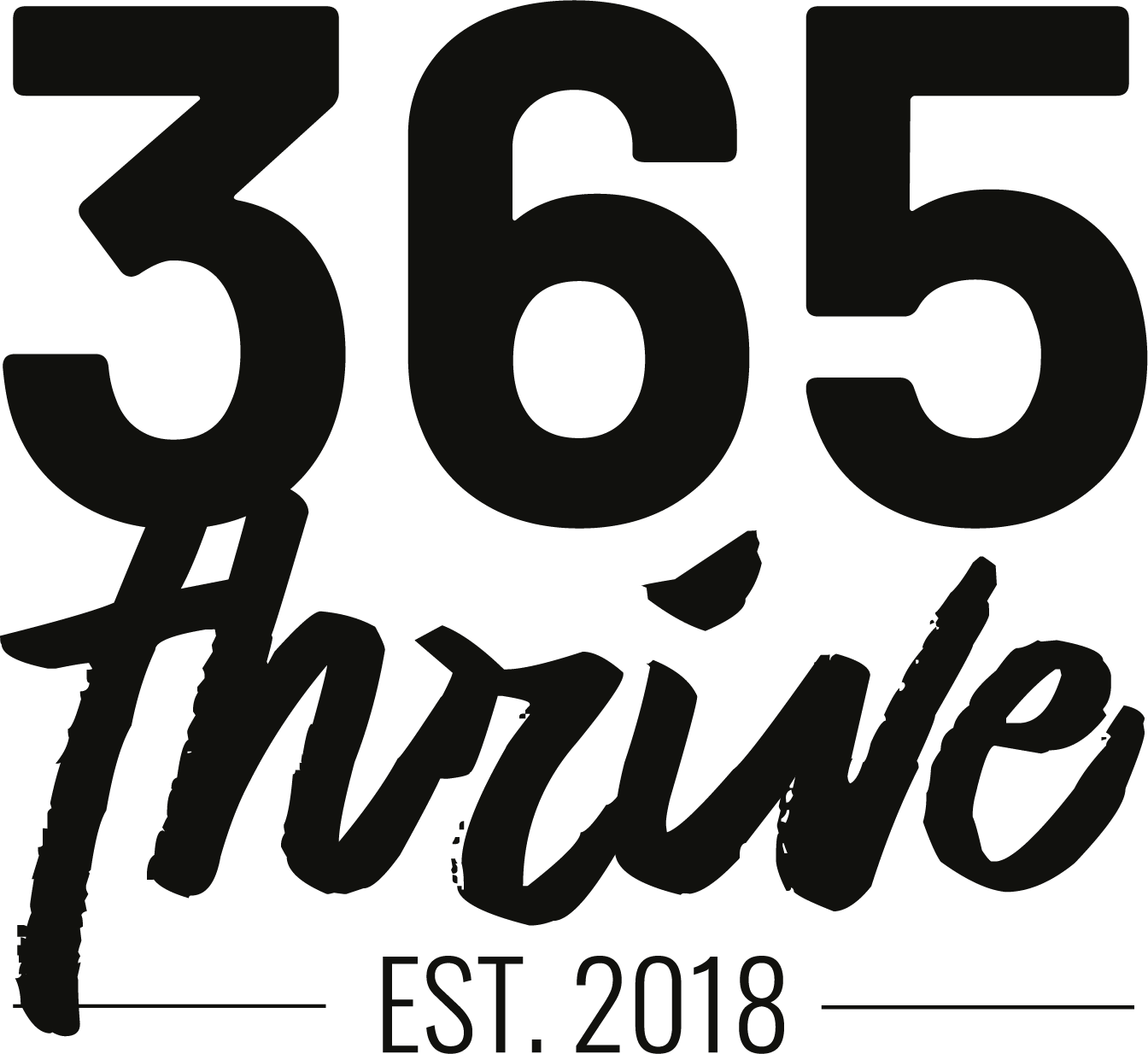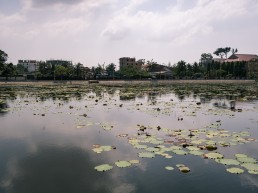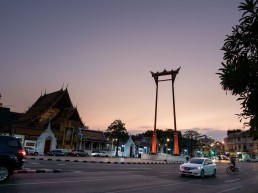At the end of 2018 we jumped on a plane to experience 3 weeks in Cambodia. During those 3 weeks there were highs, lows, moments of madness and pure disbelief. Read on for all of the good, the bad and the ugly we experienced during our trip plus tips and recommendations for things to do. Be prepared, this one’s a long one, you may want to go and get a coffee first.
The Itinerary
- Siem Reap (4 nights)
- Phnom Penh (4 nights)
- Kep (3 nights)
- Kampot (3 nights)
- Sihanoukville (4 nights)
- Phnom Penh (3 nights)
Siem Reap
After no sleep in a questionable bedroom somewhere near Phuket airport we flew to Siem Reap on Christmas morning before Santa had even finished his rounds. Upon arrival it was immediately obvious that the next 3 weeks in Cambodia were going to be very different from anything else we’d experienced yet. Everything from the countryside and the roads to the people and the atmosphere was like nothing we’d seen before.
We spent the next 4 days navigating the town of Siem Reap, it’s sights, smells, unusual food and of course, visiting the UNESCO World Heritage site of Angkor Wat. Siem Reap itself didn’t prove to be all that interesting and surprised us with its very own ‘Khao San Road’ of sorts, ‘Pub Street’. The small, but busy area was filled with bars, clubs and tourists from all over the world in the search of a cheap pint (or 10) of the local beer, ‘Angkor’. The music spilled out of every doorway into the busy walkway which doubled as a dance floor for a large group of Chinese tourists.
To add to the madness there were stalls lining the streets with all kinds of local food and delicacies including the more risque scorpions and tarantulas on sticks. If that’s not your thing then there were also plenty of restaurants to try dotted around the town and hidden down side streets.
The temples of Angkor
Although there are some sites and things to do in the town the main attractions are most definitely the temples of Angkor which are located only a short tuk tuk ride away from the centre of town. For as little as $15 USD you’ll get your very own driver for the day who will drive you from one temple to the next. For only a few dollars more you can start before dawn for the ultimate bucket list experience of seeing the sunrise over Angkor Wat. We arranged this through our hotel and started the day at the very early hour of 4:30am with our young driver who appeared as if he had only just about opened his eyes.
As we whizzed down dark side streets, we noticed that the closer we got the more tuk tuks started to appear from every direction. Before we knew it we had arrived in an overflowing car park a few minutes from the temples. After queueing and purchasing our tickets ($37 USD for a one day pass) we headed further along the road to yet another car park and then began our walk to the temple in the dark with hundreds of other sleepy and excited tourists.
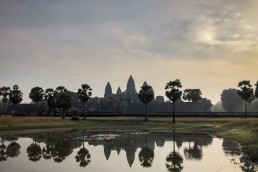
Upon arrival it quickly became apparent that we had underestimated just how busy it could be. To say it was packed would be an incredible understatement. The banks in front of the pond were lined with tripods, each one poised and ready waiting for that iconic shot of Angkor and it’s beautiful reflection. Hundreds, if not thousands of people gathered around, each trying to get in front of the other for a better view. It seemed that no matter how far forwards you went, someone would move in front of you. As we waited, more and more eager visitors attempted to clamber towards the front with little regard to anyone around them.
As the sun started to rise, shutters began to click their way through the silence. The grand temples came into view and the sun illuminated the entire scene, creating the sight that everyone had woken up so early for. It was truly breathtaking but the sheer volume of visitors had slightly tainted what could have been a highlight of any Cambodian trip.
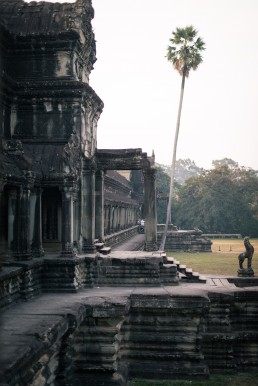
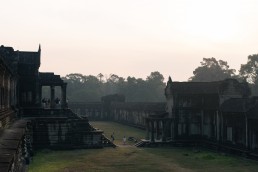
The sun had not fully risen before countless people made their way inside the temples leaving the photographers alone on the banks. We headed inside and found our morale improving as the crowds began to spread out into the many corners of the temple. The inside turned out to be the true highlight, the details were spectacular and the morning light made for the perfect photos. Wandering around exploring the many doorways and stairs in those early hours was an incredible experience and one we ended up enjoying far more than watching the sunrise outside.
After a very sickly (and not very good) iced coffee we awoke our tuk tuk driver and headed towards our next stop, Bayon Temple, also known as ‘face temple’. The incredibly unique 12th century temple is highly decorated and includes 216 faces of Avalokiteshvara. It seems that everywhere you turned there was a face staring right back at you, an experience that was both strange and fascinating. However, we once again found ourselves surrounded by so many other visitors, so many in fact that it proved quite difficult to get around. In some areas we had to wait and squeeze our way around the incredible towers and around corners we found people queuing for a chance to capture a photo in a particular spot. Unfortunately there were so many visitors that pushing and shoving seemed to be par for the course and we left not too soon after we arrived.
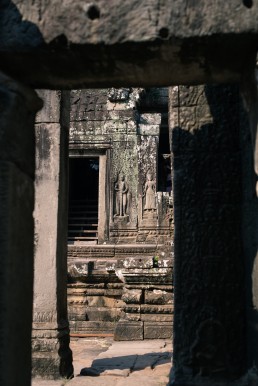
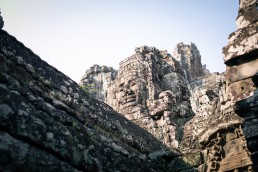
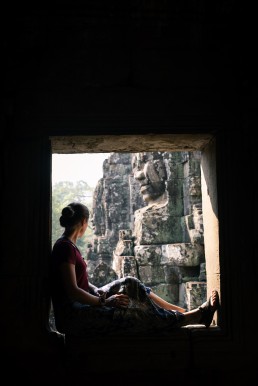
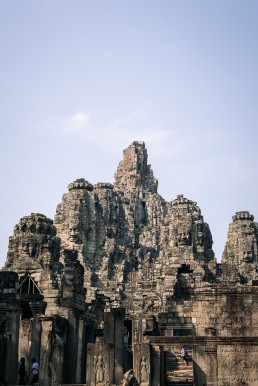
As the morning went on we continued on our route and discovered that the smaller, less popular temples were often the ones we enjoyed the most. We did however, have one more of the most popular temples to tackle – Ta Prohm, the temple often known as ‘the one that was in Tomb Raider’. The crumbling pillars had been taken over by the jungle, trees woven around the structures as if the jungle was claiming it as its own. The sheer size of these trees is quite the spectacle but you must be prepared to queue for a photo by the tree featured in ‘Tomb Raider’. At the moment the temple is currently being restored and stabilised which meant that during our visit a small section was enveloped by scaffolding rather than trees – something to bear in mind if it’s high on your bucket list.
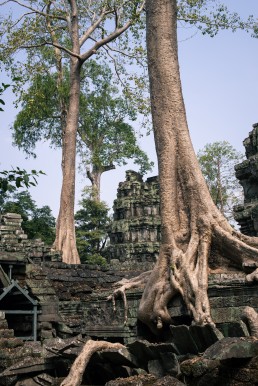
Despite it only being around 2pm we decided to head back to our hotel after seeing a total of 5 different temples. The heat and crowds are something quite extraordinary and so if you can visit early in the day you will be better off for it. Perhaps a 3 day pass would provide a better all round experience as you could take the time to visit the less popular temples and spend a little less time amongst the crowds. Furthermore, you could visit some of the many others open for sunrise rather than the extraordinarily busy Angkor Wat. Despite all of the crowds it was still an incredible experience, something that should be on anyone’s Asia bucket list.
Phnom Penh
There are a few options to consider when planning on how to get from Siem Reap to Phnom Penh. From the most expensive (flying) to the least expensive (tourist van) there are many options for varying budgets. We opted for somewhere in the middle, a slightly higher end coach with Giant Ibis for the very reasonable price of $15 USD each for the 320km journey. Giant Ibis offer a variety of routes within Cambodia and across into Vietnam. We used them for all of our journeys within the country and then onwards into Vietnam as we found them to generally be very good compared to the alternatives on offer.
The 6 hour journey from Siem Reap to Phnom Penh went relatively quickly thanks to comfortable seats, power outlets and (just about passable) WIFI. They provided bottled water and a pastry and stopped every 2 hours for restroom breaks. For lunch we pulled into a car park in the middle of nowhere and hurriedly ordered alongside many other travellers. The food was what you may expect from a bus station in the middle of nowhere in Cambodia and lead to a rather unfortunate bout of food poisoning for me the following day.
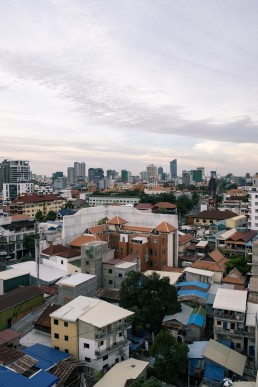
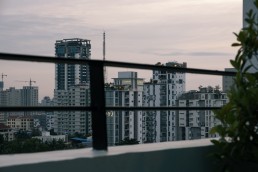
Upon arriving in the city we were quickly whisked off of the bus and flagged down one of the many eager tuk tuk drivers for a ride to our hotel. He immediately warned us to hold our bags tight and explained that theft is fairly frequent. We were warned of this by others during our stay so decided against taking out expensive camera gear out at night and tried to be subtle when using phones in the street. Generally speaking it is a safe place to visit but do be careful with your belongings when out and about.
Unfortunately for us our first day in the capital was spent in our hotel room thanks to a pretty awful bout of food poisoning. 24 hours later and we were back out into the city for New Years Eve & Tony’s birthday. We jumped in a Grab and headed out of the city towards the Choeung Ek Genocide Centre. Whilst it was not a very fun way to spend a birthday, we knew we wanted to visit and learn more about the history of the country.
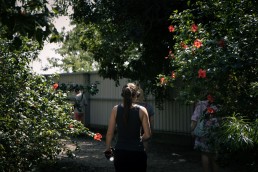
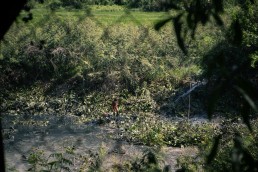
Also known as ‘The Killing Fields’, the Choeung Ek Genocidal centre sits 17km outside of the city and is the most known of all the killing fields used by the Khmer Rouge regime between 1975 and 1979. Today it is a peaceful place that acts as a memorial and an educational centre for visitors to learn of the horrors that happened in the country only a few decades ago. It is a haunting place to visit and walking around it is difficult to comprehend what really happened. The entry fee is $6 USD and includes an informative audio tour.
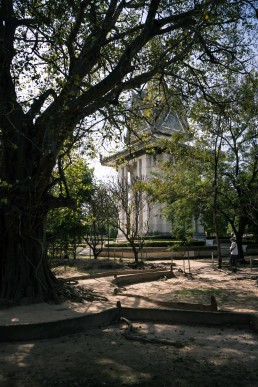
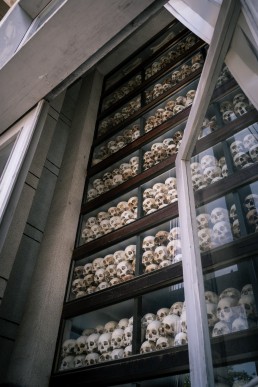
If you want to learn more, a visit to the Tuol Sleng Genocide Museum (also known as the S21 prison) in the city is a must do. The former secondary school acted as a prison for the Khmer Rouge regime during their reign between 1975 and 1979. We visited the museum on our second time in the city and found it somehow more difficult to visit than the Choeung Ek Genocide Centre.
Upon arrival we paid for our ticket, put on our headphones and pressed play, heading towards the first stop on the tour. The excellent audio guide ($8 USD) took us inside what were once classrooms but more recently had been used for imprisonment, torture and interrogation. We walked between the rooms in silence, listening to horror stories from guards and prisoners alike. Of the 14,000 known prisoners, only 7 survived and all were documented through photography. Hundreds of photos of men, women and even children line the walls, some with expressions that I struggle to describe. In addition to these portraits, images and instruments of torture lie waiting for you in other rooms. Stories from survivors filled our ears as we viewed some of the most horrific images we’d ever seen. To visit here is a haunting experience, one that will stay with you for a long time.
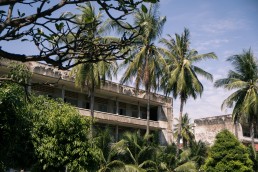
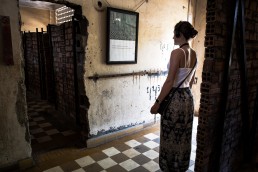
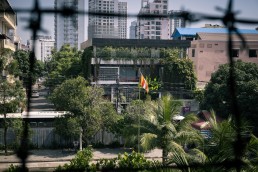
Despite all of the very recent and horrific history of the country, the capital does have a lot of other things to do and see that won’t require a stiff drink afterwards. In total we spent a week in the city, learning, eating and taking in the sights. Whilst it’s not a particularly pedestrian-friendly city (with no pavements at all in many areas) walking along the riverfront is an activity in itself.
One afternoon we navigated the hectic roads and explored the riverfront by foot. A true hive of activity, there was everything from little kids running around chasing pigeons to ladies selling crafts. From there we headed into the Royal Palace which serves as the Royal Residence of the king of Cambodia. We paid what we thought was quite a high price of $10 USD to enter, covered up and joined the flow of the crowd to head inside. In all honesty, we did not enjoy the experience. It was incredibly busy, far busier than we were expecting and we decided to leave after only 20 minutes inside.
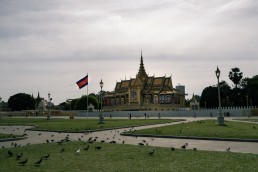
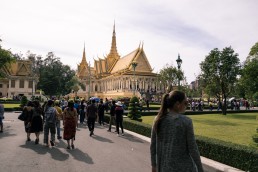
When the evenings began to draw in, there were a few spots that we particularly enjoyed for one reason or another. If a good pizza is your thing then make sure to head over to Piccola Italia Da Luigi, not too far from Independence Monument. We took refuge here on the night of New Years Eve for great pizza and a few glasses of the local beer. The food is good, prices reasonable and if you’re after a crazy experience then sit out the front of the restaurant in the tiny, yet busy street. From here we stumbled across the trendy Bassac Lane bars only a few metres away. The small lane is lined with tiny little bars each with their own theme and menu. The drinks aren’t cheap but it is a great way to spend the evening and sip on cocktails.
Another night we found ourselves above the famous Russian Market in a bar called the Sundown Social Club. We walked past stalls of all kinds from fruit and vegetable stalls to ladies selling big chunks of meat that had been hanging in the heat all day. Walking through there is an interesting experience in itself, but if an aerial view is more your thing then head up to this rooftop bar for great happy hour deals and an unbeatable sunset spot.
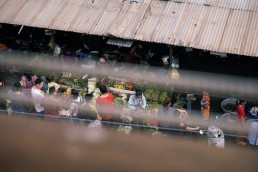
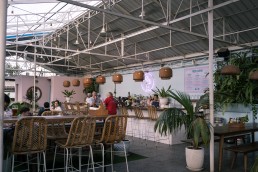
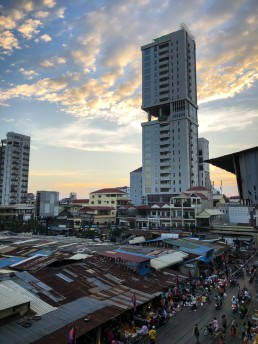
Kep
Early one morning we packed our bags and jumped on yet another Giant Ibis bus, this time to head south to the small coastal town of Kep. After a slight detour, one of the worst drivers we’ve had yet and almost getting stuck in a ditch, we finally arrived in the little town 4 hours from the city. Stepping off of the bus and retrieving our bags (now a lot dirtier than we left them), it was immediately apparent that this stop was going to be very different to the last.
We started on the walk to our place, walking alongside wide roads that seemed completely unnecessary for such a small town. The place seemed empty, almost to the point of being eerie. We didn’t walk past a single person during that 20 minute walk except one tuk tuk driver who tried to heavily overcharge us for a 2 minute drive.
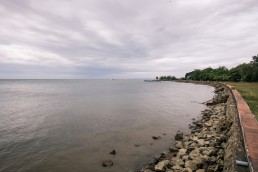
During the 4 days we spent in Kep we unfortunately could not see the draw. We struggled to find anything interesting to do, see or eat and spent more time in our hotel than anywhere else. Luckily for us, the place we were staying was a lovely set of bungalows with a treehouse style restaurant that served great food. One morning we set out on an exploration of the town in the desperate attempt to find something – anything. Unfortunately all we seemed to find was a mediocre (at best) beach, the most rubbish we’d come across yet and what seemed like never-ending, empty roads. What initially comes to mind with Kep is the crab. The small seaside town is famously known for its crab market but more recently this has become controversial due to the effects of overfishing on the nearby coral.
We didn’t get a chance to visit during our stay due to bad weather, but have heard that Kep National Park is well worth exploring, with great hiking trails and viewpoints. In addition, ‘Rabbit Island’ seems to be the main attraction, a beautiful island sitting just 4 km south of Kep town that can be visited on a day trip or overnight in simple bungalows.
To see more on our experience, check out our vlog “Is Kep worth visiting?”.
Kampot
After 4 fairly long days spent by the sea we headed to nearby Kampot only 30 minutes away in a tourist van that seemed as if it was about to fall apart. We arrived in one piece and headed to our hostel situated at the end of town. As it turned out, Kampot ended up being one of our favourite stops in the country, a peaceful riverside city that had just about enough to do whilst maintaining a slow pace.
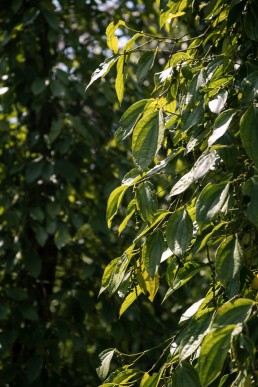
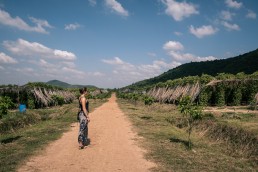
The next four days were filled with surprisingly good food, incredible views over the river, watching sunsets and exploring the top sights of the area. Of course, that meant jumping in a tuk tuk and heading to La Plantation for a tour & tasting of what is said to be ‘the best pepper in the world’ by top chefs. A truly unique experience, we walked around the plantation and tasted peppercorns in a way that you may visit a vineyard and experience a wine tasting.
Stay tuned for a full blog post coming soon on what to do in the city, where to eat and of course, where to find great coffee.
Sihanoukville (Otres Beach)
From Kampot we headed almost 100km west to the city of Sihanoukville. We did not have very high hopes after hearing many travellers accounts of a place that had once been a backpacker haven but was now described as a place to avoid. With only a few days left in Cambodia and after the shock of the prices to get to Koh Rong Samloem, we decided to head there anyway, thinking ‘it can’t be that bad…’. Little did we know it would be our greatest disappointment yet and actually the worst experience we’ve had on our travels to this day.
As the taxi turned right into Otres village we gazed out of the window towards the dusty road filled with rubbish and rubble. 5 minutes later we pulled up outside our place and proceeded to check in to what would be our worst accommodation yet. Over the 5 nights we spent there, we did not have one night of good sleep. From the heavy construction just behind our bungalow to locals and travellers screaming and shouting late into the night, it was an impossible situation. That first night we did not sleep at all and the heavy construction began at 6am before the sun had even fully risen. The power would cut out and the water stopped running, making it impossible to stay cool and clean.
Finding a good place to eat was also fairly problematic as all restaurants seemed to be open to the elements – and by elements, I mean flies. Eating with two hands was not an option as one needed to be used as a swatter to keep insects off of your food. There were a few good places to eat in the village from the great pizza and French wine at Jin to the huge burritos at The Joint. For authentic Italian pasta dishes head to the little place just left of Woody’s.
On a few occasions we ventured out of the village and onto the main road that headed towards the beach. However, calling it a ‘road’ is a bit of a stretch – it’s more of a dirt track lined with heaps of rubbish and rubble from the many construction sites in the area. Walking further along the road it becomes quickly apparent that it would be more accurate to describe the city as one giant building site rather than a city. The increase in construction over the last few years is astonishing, with further work planned in the upcoming years by large Chinese construction companies. Overbearing hotel/casino combos stand tall above most of the city with the promise of much more to come. Unfortunately that seems to be the direction the area is going in with no signs of stopping and the increase in Chinese shops and restaurants only supports this move. What once used to be a relaxing, budget beach location for hippie backpackers is now a city filled with construction sites and rubbish.
Reaching the end of the road, past the construction and fenced off areas, we made it to the beach. The soft white sand, towering palm trees and sparkling water was only a sad reminder of how beautiful this place once was. Now the beach seemed to be littered with rubbish and had the unfortunate backdrop of cranes and casinos.
Those 5 nights in Otres were some of the slowest of the trip so far. We were so eager to leave that we headed to the bus station early and jumped on the bus half an hour before it was due to leave. It turned out that the bus only had a few people on it so that 6 hour journey turned out to be one of the best by far – probably also because we felt such a feeling of relief as we pulled out of the city.
To see more on our experience, check out our vlog “Why you should avoid Sihanoukville in 2019 and beyond”.
We finished off the 3 weeks in Cambodia with a few nights back in Phnom Penh before heading on to our next country, Vietnam by – you guessed it – a Giant Ibis bus. The trip truly had been a whirlwind, a roller coaster of emotions filled with everything from bucket list experiences to food poisoning and construction sites. If we were to do it again we would head straight to the islands of Koh Rong Samloem and Koh Rong. As far as we’re aware the former is still a slither of paradise where you can string up a hammock and switch off from the world. Well, that sounds pretty good to us.
Have you been to Cambodia? How was your experience?
Happy adventuring,
Lorna
Share
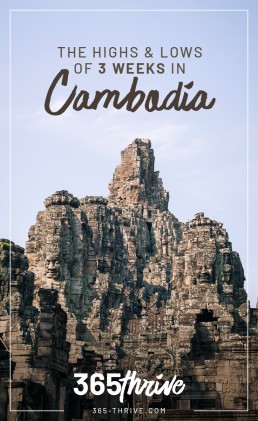
CAMBODIA VLOG SERIES
We have a whole vlog series on youtube from our 3 week trip through Cambodia – check them out over on our channel by clicking below.
Related posts
5 things to do in Kampot, Cambodia
During a 3 week trip through Cambodia late last year we spent 4 days exploring the sleepy riverside…
10 things you must do in Bangkok, Thailand
Bangkok really does have a little bit of everything, from brilliant shopping to delicious food and…
